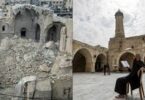ISTANBUL (AA): The Hagia Sophia Grand Mosque in Istanbul has been undergoing restoration and maintenance with the most advanced techniques and will serve as an exemplary model for the world, Istanbul Provincial Director of Culture and Tourism Coşkun Yılmaz said.
Speaking to Anadolu Agency (AA) about the restoration work at the Hagia Sophia Grand Mosque, Yılmaz said that the historic building was a place of protocol where coronation ceremonies were held in Roman times, and important ceremonies were also held in the Ottoman period.
Stating that the Hagia Sophia Grand Mosque has a history of 1,500 years, and the political, social, cultural and natural disasters in the region affected its structure, the provincial director continued: “Hagia Sophia was burned in the Nika Riots, which took place against Byzantine Emperor Justinian I over the course of a week in 532 A.D. It witnessed the Latin invasion of the city by the Crusaders in April 1204 and was exposed to major earthquakes, fires and many other disasters. Throughout its history, it has reached the present day by overcoming many difficulties and continues to live on as one of the most important holy places in human history.”
Yılmaz stated that the Ottoman Empire placed great importance on Hagia Sophia, and one of the first things that Sultan Mehmed II, who conquered Istanbul in 1453 and is also known as Mehmed the Conqueror, did was to protect the mosque.
Noting that Hagia Sophia underwent great maintenance and restoration works during the period of Sultan Selim II (1566-1574) and Sultan Murad III (1574-1595), Yılmaz said: “In fact, the support, maintenance and repair work that carried the Hagia Sophia from the 16th century to the present day was carried out by Mimar Sinan, the greatest architect of the classical period of Ottoman architecture. Many architects believe that if the repairs were not carried out by Mimar Sinan, we would be talking about a ruined Hagia Sophia today. For this reason, it is possible to position Mimar Sinan among the architects of Hagia Sophia.”
Yılmaz added that the biggest maintenance works of the structure after Mimar Sinan were commissioned by Sultan Abdülmecid (1839-1861) and carried out by the architect Gaspare Fossati. “The Ottoman contributions in the history of the Hagia Sophia were not only maintaining and repairing works. There was a tradition of the ‘social complex’ in the Ottoman Empire.
Social complexes comprised buildings of various services built around mosques. Mosques were not only used as a house of praying but also as a place for eating, teaching, health care and as a hostel for the poor thanks to their social complexes. The Ottomans transformed Hagia Sophia into an Ottoman complex with the additions they made after the conquest.” Expressing that the first additions to the Hagia Sophia were the minaret and madrassa, Yılmaz stated that almshouses, tombs, fountains, a primary school and a library were other additions in later periods.
Providing information about the restoration works, the director said, “We can say that the repairs have been carried out for 20 years with great care, patience and scientific sensitivity, in accordance with the 1500-year history of the Hagia Sophia Grand Mosque. Extensive work was carried out, especially in the restoration of the interior and dome of the structure.”
Yılmaz said that the studies were carried out by the architects and restorers of the Ministry of Culture and Tourism, as well as by academicians who have researched the Hagia Sophia at various universities.
Emphasizing that first-degree expertise in the restoration, maintenance and repair of the Hagia Sophia is essential, Yılmaz said, “We source the required level of expertise and services needed to preserve the historic building and its cultural heritage, and carry out works with great sensitivity.”
“Sometimes it is necessary to evaluate and use three to five different methods to repair a marble of this structure. It may seem strange to people, but even a piece of marble as small as the head of a pin is detected and photographed, millimetric calculations and drawings are made for it during the restoration works.
This is what it may take to restore this small marble sometimes. Such meticulous work is being carried out here. As a historian who has hosted many architects, diplomats and experts who are interested in Hagia Sophia, I can say that the best experts have achieved the best result with the most advanced techniques in the world in the restoration of the Hagia Sophia. Turkey, with Hagia Sophia, sets an example of how the cultural heritage of different faiths and civilizations can be protected with a perfect system for the world.”
Yılmaz lastly stated that President Recep Tayyip Erdoğan was also closely involved in the restorations in Hagia Sophia both during the museum period and during the process of converting it back into a mosque.






